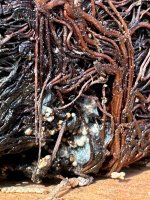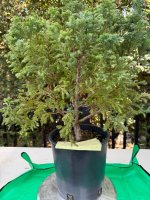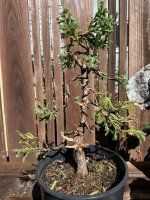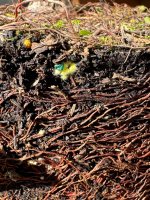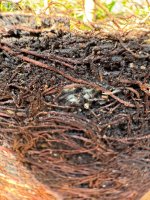MrBonsai19
Seedling
- Messages
- 20
- Reaction score
- 15
I am relatively new to bonsai, and not sure what is the next step to help this tree recover its health. I am in northern california zone 10a. I purchased the tree in August for $15 USD, so it was a minimal investment but I would definitely like to learn why I have caused this tree to decline in health. I think it might be overwatering leading to fungus or mold in the roots, but I did read that Sawara 'Boulevard' cypress likes to stay moist and I have been trying to water with that in mind. I am not totally sure if this is a 'Boulevard' cypress or some other cultivar, but just going off my best guess. I let the tree dry out between waterings but not as much as I do for other conifers. Maybe that is the issue?
On 10/13 I created a mixture of 1tsp neem oil, 1 tsp insecticidal soap, 1 gallon of water, and I watered the tree with this solution. It did not respond all that well, the canopy has started sagging a lot, but my hope was the neem oil would address what looks like fungus to me in the roots. However now I am not sure if I have the right approach and would welcome any insight what's going on. Here is a more in-depth video recording of the issue as well:
IMG_1231.MOV
I would very much like to repot this tree and it is taking a lot of self-control to wait until end-of-winter next February in about 4.5 months. Is this a scenario that justifies a high-risk repot right away? Probably not, the tree does seem to be surviving but not all that well. It will probably limp along until February but I worry at that point it might be too unhealthy to repot anyway. Especially if the current issue continues to get worse if I cannot solve the problem.
Thanks for any help or insights!
On 10/13 I created a mixture of 1tsp neem oil, 1 tsp insecticidal soap, 1 gallon of water, and I watered the tree with this solution. It did not respond all that well, the canopy has started sagging a lot, but my hope was the neem oil would address what looks like fungus to me in the roots. However now I am not sure if I have the right approach and would welcome any insight what's going on. Here is a more in-depth video recording of the issue as well:
IMG_1231.MOV
I would very much like to repot this tree and it is taking a lot of self-control to wait until end-of-winter next February in about 4.5 months. Is this a scenario that justifies a high-risk repot right away? Probably not, the tree does seem to be surviving but not all that well. It will probably limp along until February but I worry at that point it might be too unhealthy to repot anyway. Especially if the current issue continues to get worse if I cannot solve the problem.
Thanks for any help or insights!

